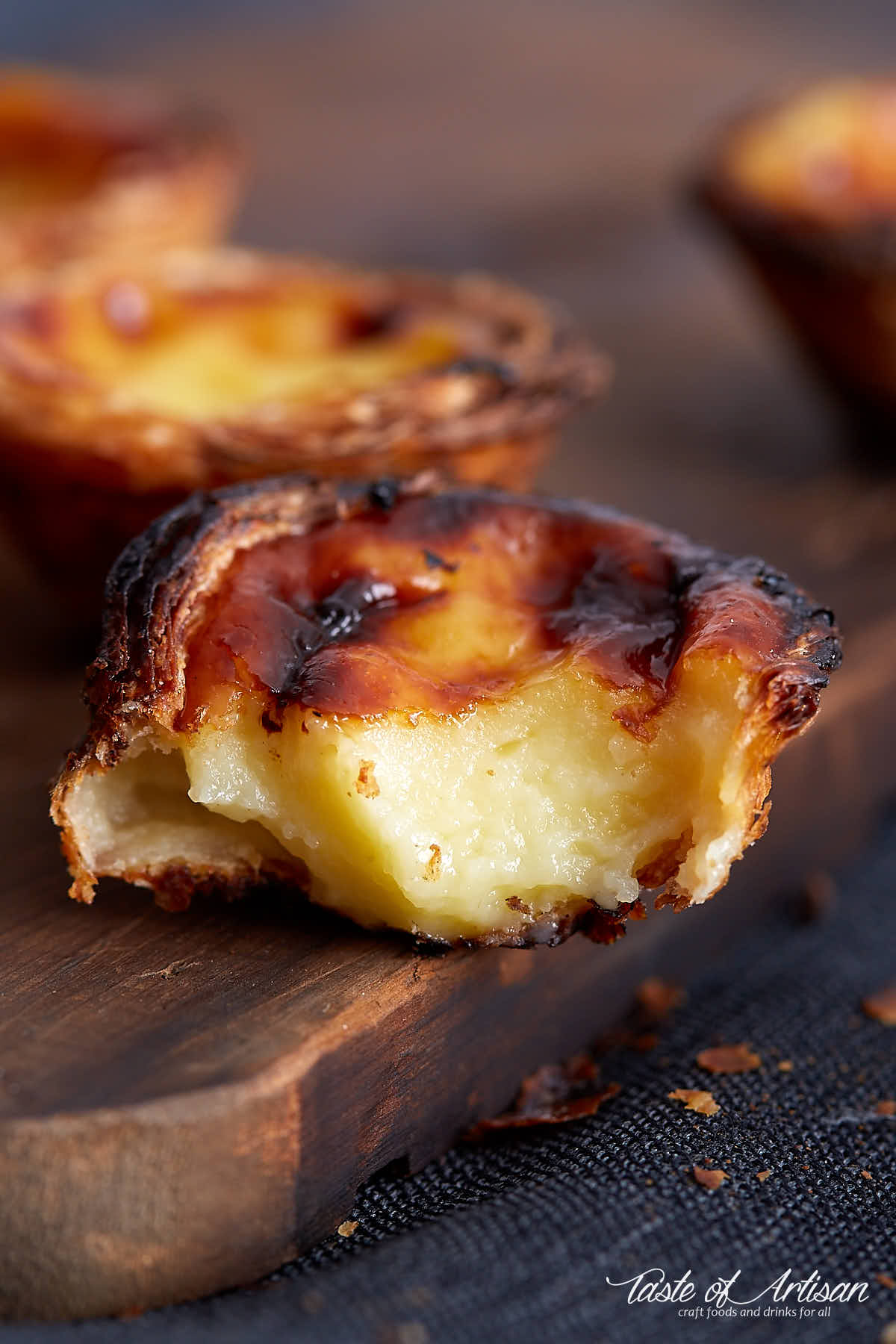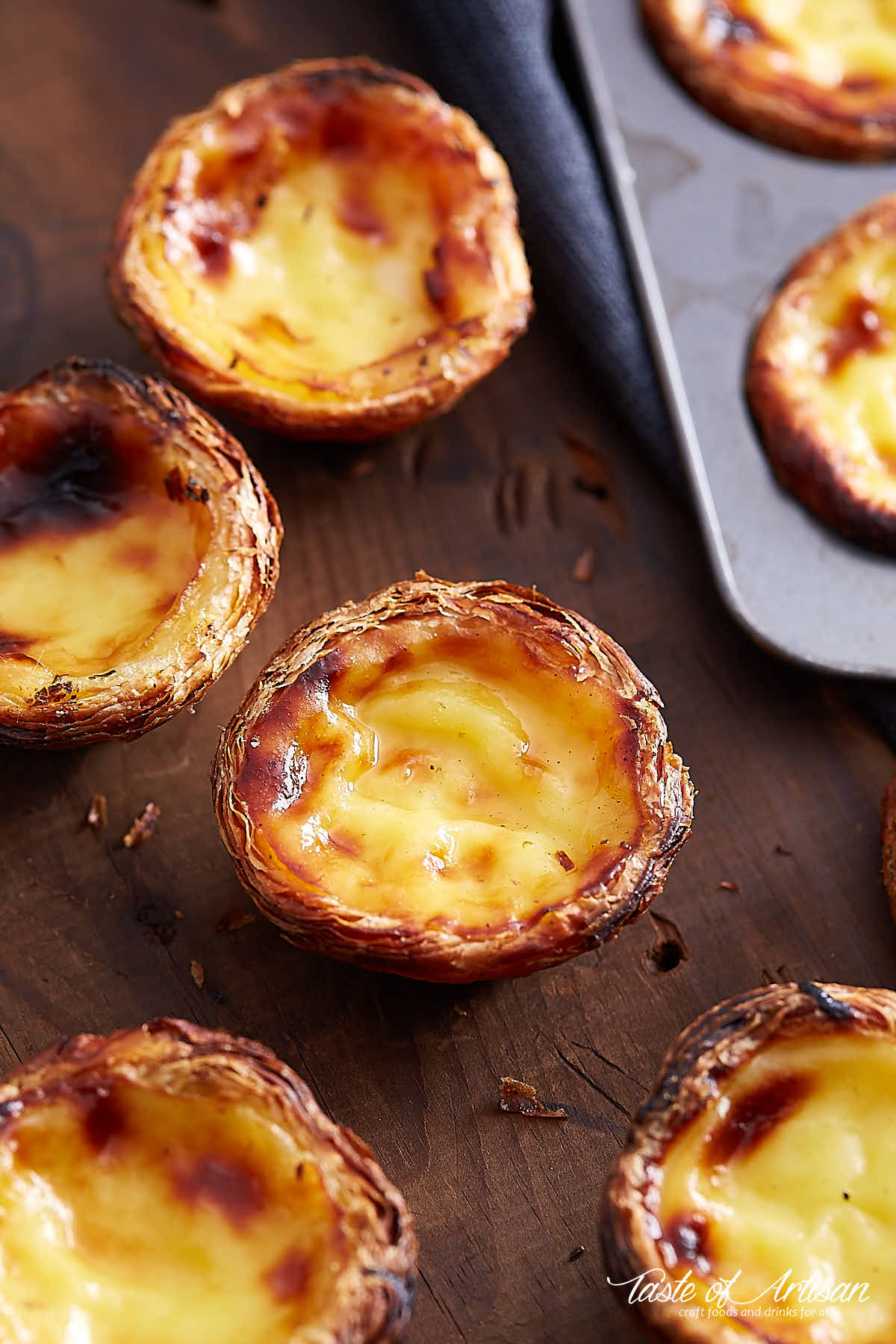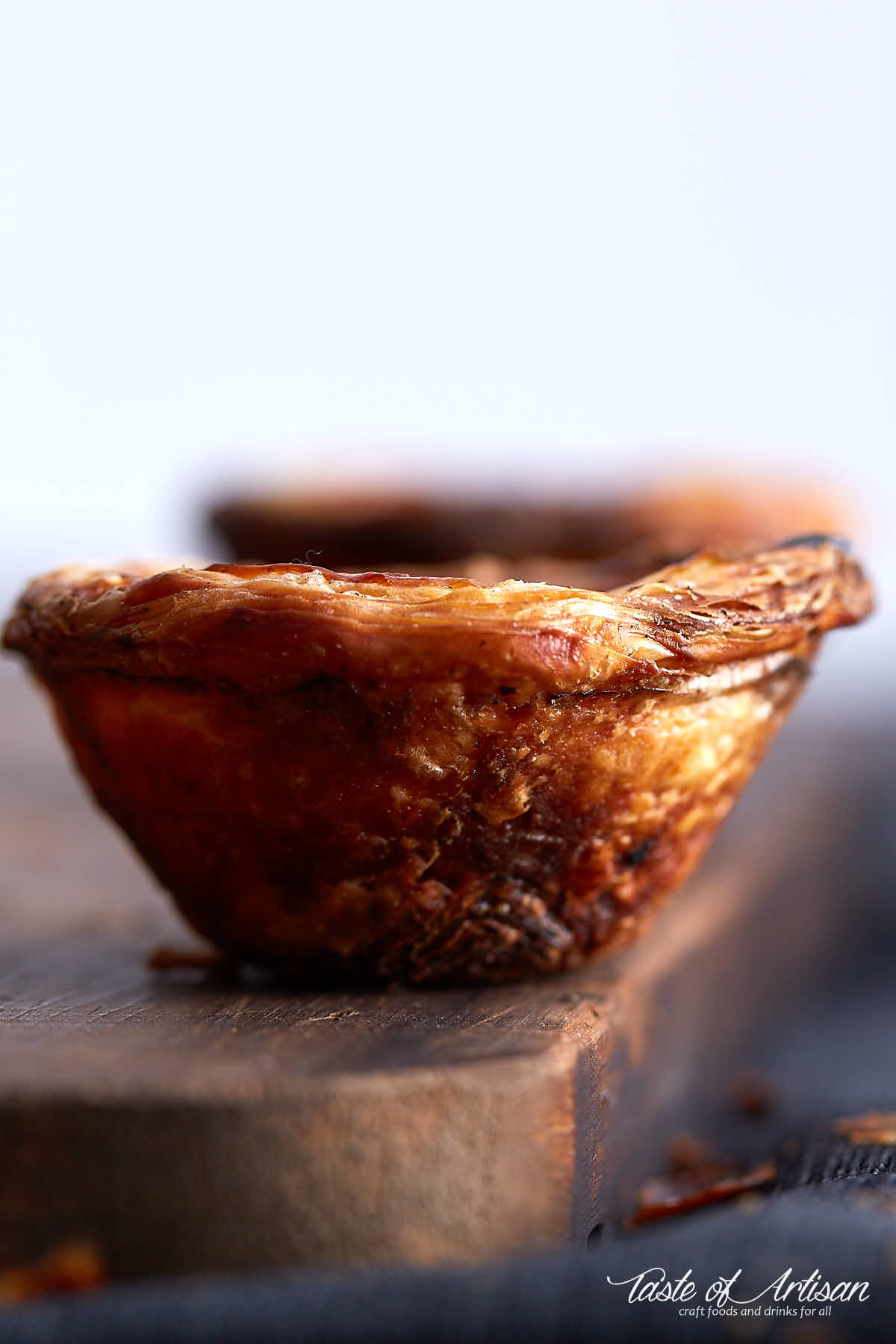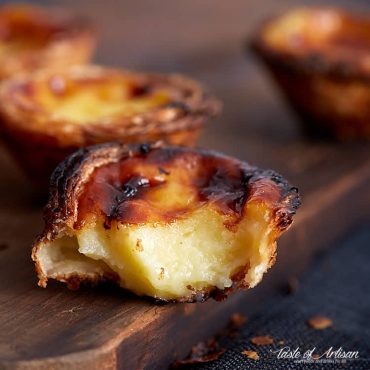
If you've ever tried authentic, traditional Portuguese custard tarts you know they are heavenly and in the league of their own. Making them at home is no more difficult than making croissants or custard based ice cream. If you've ever made those, this recipe should be a piece of cake for you.
The eternal problem is making them crispy and beautifully browned in the home kitchen oven. Almost every recipe I've tried warns you upfront that your tarts may not (read will not) brown as much as on the pictures they attach. Hm... There's got to be a way. After many trials I can say yes, you can get them to brown and look like real authentic Portuguese custard tarts.
The solution, as was the case with making French caneles that I described in my Perfecting Canele Recipe and Technique post, was high heat plus a quick modification to the oven (no worries, you don't need to take your cooker apart).
This recipe for the Portuguese custard tarts comes from David Leite's of Leite’s Culinaria who sourced it from Antiga Confeitaria de Belém in Lisbon, Portugal. While there are many other good recipes for Portuguese custard tarts out there, I chose this one based on predominantly positive feedback.
As usual, I made a few adjustments to suite my taste. I made powdered sugar and cinnamon optional as I think the pastry is sweet enough on its own. Not using cinnamon is a personal choice. Add it back if you like it. I also chose to use a regular size muffin pan (cups about 2.5" by 1.5") instead of a mini muffin pan. This makes it a bit easier to finish the recipe as you only have to make two batches instead of three. Larger size custard tarts also require longer baking time which helps with browning.

Tips for crispy, flaky, and very nicely browned pastry for Portuguese custard tarts
Follow these tips and you will have one heck of a dessert and eternal respect and love from your friends and family.
Tip # 1
When laminating your dough make sure the butter is evenly layered, all excess flour and air pockets are removed, and the dough is rolled very thin and folded neatly.
Tip #2
Use an accurate and fast instant read thermometer, e.g. ThermoWorks Super-Fast Thermapen or Lavatools Instant Read Meat and Food Thermometer, to quickly and precisely measure custard temperature. If the temperature gets even a few degrees higher than specified it may ruin the custard beyond saving. Custard begins to set at around 160F - 165F and begins to curdle if heated past 175F.
Tip # 3
Use aluminum (or copper ) muffin pans. Copper ones are hard to find and are super expensive. Aluminum ones, like this Nordic Ware Natural Aluminum Commercial Muffin Pan, won't break the bank will do the job very well. Carbon steel pans are great too, they heat very quickly, but require high maintenance due being prone to rusting. Stainless steel muffin pans are not my favorite as they don't conduct heat as well as copper or carbon steel. They look pretty though, and are easy to clean, if that's your thing.
You should not put non-stick cookware in an oven hotter than 500F as non-stick coating releases harmful chemicals at high temperatures. Aluminum or copper conduct heat better too.

Tip # 4
Preheat your oven for no less than 1 hour. Even if it beeps telling you it's ready, it's not.
Tip # 5
The secret to proper browning is high and sufficient radiating heat. You won't get that from your kitchen oven without a modification. The good news is that a simple mod is all that's required. Place a 14 by 16 inch baking stone below and another one above the muffin pan in which you will be baking your Portuguese custard tarts.
I really like the stones sold under the name of Old Stone Oven Rectangular Pizza Stone and I have been using them for over two years now. They are large and thick enough to provide plenty of radiating heat. The stone below should be right under the muffin pan. A thick enough stone stores a lot of energy that will be radiated during baking and will help the tarts crisp and brown quickly and evenly. These stones are also indispensable for baking things such as baguettes (French Baguette Recipe) or bread (How to Make Sourdough bread in 6 Easy Steps).
If you don't have two pizza stones, no problem. Use unglazed tiles or even red bricks to make two layers above and under the muffin pan. The thicker the stones or tiles are, the better. Bricks will be the best, but they do need a much longer preheating time and are a hassle to move in and out of the oven.
Tip # 6
Portuguese custard tarts are best eaten warm the day they’re made. The crispiness will be gone by the next day or so.

Portuguese Custard Tart Recipe
Ingredients
For the dough
- 2 cups all purpose flour (level; about 272 g)
- 1/4 tsp sea salt
- 14 Tbsp water (3/4 cup plus 2 Tbsp; about 207 ml)
- 1 cup butter (unsalted, room temperature, stirred until smooth; about 227 g)
For the custard
- 3 Tbsp all-purpose flour (27 g)
- 1 1/4 cups milk (divided; 296 ml)
- 1 1/3 cups granulated sugar (264 g)
- 2/3 cup water (158 ml)
- 1 cinnamon stick
- 1/2 tsp pure vanilla extract
- 6 egg yolks (whisked)
- Powdered sugar (optional)
- Cinnamon (optional)
Instructions
- To make the dough, place the flour, salt, and water in the bowl of a stand mixer fitted with a hook. Mix for about 30 seconds until soft and pillowy dough forms that cleans the side of the bowl.
- Place the dough on a generously floured work surface. Pat the dough into a 6-inch square using a pastry scraper. Sprinkle with flour, cover with plastic wrap, and let the dough rest for 15 minutes.
- Roll the dough into an 18-inch square. Use the scraper to lift the dough and add flour underneath to avoid the dough sticking.
- Brush excess flour off the top of the dough, trim any uneven edges, and using a small offset spatula dot and then spread the left two-thirds of the dough with a little less than one-third of the butter to within 1 inch of the edge.
- Neatly fold over the unbuttered right third of the dough (using the pastry scraper to loosen it if it sticks), brush off any excess flour, then fold over the left third. Starting from the top, pat down the packet with your hand to release air bubbles, then pinch the edges closed. Brush off any excess flour.
- Turn the dough packet 90 degrees to the left so the fold is facing you. Lift the packet and flour the work surface. Once again roll out to an 18-inch square, then dot and spread the left two-thirds of the dough with one-third of the butter, and fold the dough as in steps 4 and 5.
- For the last rolling, turn the packet 90 degrees to the left and roll out the dough to an 18-by-21-inch rectangle, with the shorter side facing you. Spread the remaining butter over the entire surface.
- Using the spatula as an aid, lift the edge closest to you and roll the dough away from you into a tight log, brushing the excess flour from the underside as you go. Trim the ends and cut the log in half. Wrap each piece in plastic wrap and chill for 2 hours or preferably overnight.
- Now make the custard. In a medium bowl, whisk the flour and 1/4 cup of the milk until smooth. Set aside.
- Bring the sugar, cinnamon, and water to a boil in a small saucepan and cook until an instant-read thermometer registers 220°F (100°C). Do not stir.
- Meanwhile, in another small saucepan, scald the remaining 1 cup milk. Whisk the hot milk into the flour mixture.
- Remove the cinnamon stick then pour the sugar syrup in a thin stream into the hot milk-and-flour mixture, whisking briskly. Add the vanilla and stir for a minute until very warm but not hot. Whisk in the yolks, strain the mixture into a bowl, cover with plastic wrap, and set aside.
- Assemble and bake the pastries
- Heat the oven to 550°F (290°C) with two baking stones inside for at least one hour. Remove the pastry from the refrigerator and roll it gently back and forth on lightly floured work surface until it’s about an inch in diameter and 15 inches long. Cut it into scant 1.25-inch pieces. Place the dough pieces cut-side down into each of the the 12 cups of the 12-cup aluminum muffin pan (each cup measuring about 2.5" by 1.5"). Let the dough pieces often several minutes until they become soft and pliable.
- Dip your thumbs into the water, then press straight down into the middle of the dough piece. Flatten it against the bottom of the cup to a thickness of about 1/8 inch, then smooth the dough up the sides and create a raised lip about 1/8 inch above the pan. The pastry sides should be thinner than the bottom.
- Fill each cup 3/4 full with the slightly warm custard. Bake the tarts until the edges of the dough are frilled and brown, about 10-12 minutes.
- Remove from the oven and allow the tarts to cool a few minutes in the pan, then transfer to a rack and cool until just warm. Repeat the steps with the remaining dough and custard mix.
- Serve and enjoy. Optionally, sprinkle the tarts generously with powdered sugar, then cinnamon before serving.
Notes
Nutrition
Updated on March 19, 2017


Steph G says
OMG! Absolutely delicious (and, as another happy baker said, very labour intensive! 🙂 - but totally worth it. I did find the custard wasn't really thick enough with just whisking the yolks into the warm milk/flour/sugar mixture, so I cheated a bit by whisking the whole shebang over a low heat until it thickened more convincingly. Other than that, the recipe produced really authentic looking (and tasting!) Portuguese tarts. Thanks for another winner.
Victor @ Taste of Artisan says
Glad to hear it, Steph. Enjoy!!!
Leisa says
I really want to make this recipe for our winter Solstice and in remembrance of my dad. Only I have one small issue and that is I can't use cow's milk. Can I substitute coconut milk and plant based butter or even goat milk and goat butter?? Thank you.
Victor @ Taste of Artisan says
Hm... that's a good question. Frankly, I have no idea as I've never experimented with those specific substitutions. Perhaps someone else has and may chime in here. Good luck!
Linda says
Is the muffin pan placed directly on the stone?
Cheers,
Linda
Victor @ Taste of Artisan says
Yes, direclty on the stone.
Irma says
Excellent recipe. Made three batches with great success.
Chris says
I had a question I moved to the south and wanted to make this for my husband's family since they know nothing Portugese as it is not around here, and such. I wanted to ask what's your advice if the oven only goes up to 500°F ?
Victor @ Taste of Artisan says
Hi Chris, if your oven only goes to 500F than I'd start with that and see how it goes. Different ovens bake differently so you may be surprised. Let me know how it goes.
Aurea says
Hi. My I use French flour to do the custard? Thank you
Victor @ Taste of Artisan says
Should be no problem.
Jennifer says
Hi. Can you use puff pastry sheets?
And would the baking time and temp be different in a convection oven?
Thanks!
Victor @ Taste of Artisan says
Jennifer, I don't see why not but I've never tried. As far as cooking time, I can't say but it should be very similar. Just go by the appearance - when they look nicely browned they are ready.
Maria Camara says
Hi im tryin to make the puff pastry and always having issues what kind of butter are you using thank you in advance
Victor @ Taste of Artisan says
Maria, I use Costco unsalted butter most of the time. I've used butter from other places too but didn't find much if any difference to be honest.
Maria Camara says
Thank you and my oven is gas what temperature you think i should set it at
Victor @ Taste of Artisan says
Hi Maria, sorry for the delay with my response. I honestly don't know what your settings are, but see if you can identify which temp each one corresponds to. I now have a gas oven too but mine has markings in Fahrenheit in 25-degree increments.
Mary says
In Toronto, Ontario Canada, we have a lot of Portuguese bakeries and we can buy these just about anywhere. Years ago, I had the authentic tart in Lisbon. The ones I get in Toronto taste identical. I can eat three at a time, they’re so good. I will however try your recipe.
Anya says
Holy guacamole these were the BOMB. They turned out... beyond words incredible. They were just as good as the ones in Portugal, if not better. The crusts were soooo flaky and the custard was perfect. However I will say this is one of the most time-consuming and labor intensive things I ever baked. It was totally worth it though.
GivemeKitchen says
Excellent description - knows the 'secrets' behind a good Pastel de Nata. Well done!
Chelsea says
So many compliments on these! Best custard tarts I've ever tasted!
Victor @ Taste of Artisan says
So happy to hear that, Chelsea. Happy baking!
Ashanti says
I could not refrain from commenting. Perfectly written!
jin says
hello
Thank you for your recipe.
The custard cream turned black(not Caramelizing) in less than five minutes when it started baking at 260°C.
Bake for more than 10 minutes and the shell is over-cooked.
Please I'd like to ask advice of you
Victor @ Taste of Artisan says
I suggest dropping the temperature and/or moving the baking pan down. Sometimes it takes a bit of experimenting as, as they say, everyone's oven bakes differently.
Kendra says
Hi Victor - If you make the custard ahead of time, are there any adjustments needed when it's time to bake them (i.e. amount of time, temp, etc)? And is it in Step 12 where the 160-165F comes into play? TIA!
Victor @ Taste of Artisan says
Hi Kendra, yes, it's in step 12. When making custard ahead, you can bring it to room temperature or use it right out of the fridge. It will take a few minutes longer to bake if using cold custard, but shouldn't be much longer. Don't worry about the extra time, go by appearance. When they look brown and crispy, that's when they are ready.
Kendra says
Great, thank you!!!
Judy says
The dough is done and in the oven. I do have two pizza stones. My question is - do I place the egg tarts directly on the bottom stone, and then another stone on the rack about? thanks for the answer in advance.
Victor @ Taste of Artisan says
Yes, that's how I bake mine.
Becky says
My custard didn’t brown at all. Is that because I didn’t use the pizza stone recommended? I only have 1 pizza stone, would it help to use it on the rack above muffin pan vs the bottom?
Thanks in advance for your help.
Victor @ Taste of Artisan says
Becky, you need strong heat from the top so yes, a hot baking stone over the tarts will help with browning. Alternatively, try moving the tray up as much as you can. The heat from the hot top of the oven will help too. If both fail, try finishing on broil but keep a close eye on the tarts while you are ding it, they will brown very quickly.
allan says
I make them all the time, in Australia I use pampas butter puff pastry, works a treat and no mess, have no problem crisping them on a normal oven at 260.
Cheers
allan
Adriana says
Thank you so much for sharing this recipe! I have been wanting to make these forever!
Bobby says
Love the recipe, just have a quick question. You mention to have an instant thermometer for the custard temperature. Is this when making the custard or while it's cooking in the oven? Also, couldn't find in the recipe what exactly the temperature has to be either! Please your help is appreciated!
Victor @ Taste of Artisan says
Hi Bobby, good question. I should not have made assumptions and mentioned the temperature in the post, will do that. Custard begins to set at around 160-165F and if heated to over 175F it will most likely to curdle.
Tina says
Thanks for your amazing recipe and tips!
But there is something a bit confusing... Do I have to PREHEAT with baking stone? or not?
Victor @ Taste of Artisan says
You are very welcome. Yes, you need to preheat the oven with the stone inside.
Maria says
It’s been 40 years since I enjoyed these wonderful pasteis in Lisboa.
I don’t remember cinnamon ... is that authentic or is my memory fading!
Can’t wait to try this recipe ASAP.
Jeff says
At the Bakery in Belem outside of Lisbon they bake between 10-15,000 tarts each day. People stand in line outside to buy them. You can buy as few as one or by the dozens And yes, they give a little packet of cinnamon with each sale. I bought them many times never paying attention to the little packet. One time I noticed it and tried it. It was the icing on the cake, or the spice on the tart. I loved it.
Abigail says
We love these tarts in our house. Seriously high praise since all five of us have notibly different tastes yet agree on these.
Cris says
The tart looks delicious...Thanks for sharing 🙂
Dina says
Thank you for sharing. Your tips have been very helpful.
Anna says
Hi! The custard tarts look amazing and I can't wait to try them out! Quick question: is it possible to use pre-made puff pastry? I'm not very good at working dough 🙂 Thank you!
victor says
Never tried pre-made and not sure which one would work well... but I can assure you, making puff pastry is much easier than most believe it is. 😉
Anna says
I guess I'll give it a shot then 🙂 Thank you for the quick reply!
Shirley Morgan says
Good morning Victor in Canada from myself in Victoria, Australia. I've just come across your 'Portuguese Custard Tarts' recipe and can't wait to make them. I only recently tasted these at a market at Brisbane, Australia while staying with my daughter. Thank you .. so nice being in touch. .. Shirley M.
victor says
Good morning, or good evening, Shirley. Welcome to my blog and happy to see you here. Portuguese custard tarts are my favorite dessert, or at least in the top 3. Well worth the effort.
Porlloh says
We had "the real deal" this summer in Lisbon, and everywhere else we could get our hands on these bits of deliciousness...clearly we love them! Your recipe is super! I made the pastry (first time for me - so much fun!), the whole situation was wonderful! We had them as dessert for a birthday dinner, and people could not have enjoyed them more! Made another batch this week as I didn't have enough last week.
Thanks for helping me to have a little bit of Portugal in my home!
victor says
You are very welcome!
Annette says
These look delicious and your instructions are excellent. I have a gas oven with a convection setting. Since that radiates the heat, would that work instead of using the baking stones? I’m anxious to try these, as well as your caneles recipe. I’ve got my beeswax, I’m just waiting for my molds to arrive!
victor says
Oh... can't say as I've never used a gas oven in my life. You can always start with just one and see how it turns out. You may like the results without a stone.
Jean says
Hi this recipe sounds and looks great. I’m on holiday now. I can’t wait to get home to try this. Thanks for the tips.
Weihsin says
Victor,
Made these tarts a while back according to your instructions and they turned out great. The only thing I wanted to improve was the texture of the custard. It comes across a bit glugly and not smooth and creamy as I would like it.
Tried to paste a photo of the tarts I baked but couldn’t get it to work...
victor says
Hi Weihsin, glad to hear about your success. The custard takes a little practice to master but is not that hard to make creamy once you get a hang of it. You can email me the photo and I will attach to you comment.
Olivia says
These were devine! First time making them and loved them! My oven couldn't reach 290 so settled on 240 then extended the baking time by about 8-12 mins. Custard turned out wonderful! I just need to make sure the pastry is thinner in the muffin tin to ensure it cooks through as my first batch of pastry was too think so had half baked pastry bases. But other than that - AMAZING! and loved the vanilla in the custard! PS i didn't make your pastry - i bought some pastry. Next time i'll attempt making some puff pastry from scratch!
Barrymore says
This is the same recipe as the one on Leites Culinaria.
The only difference is you add the baking stones. I appreciate your addition. Looks like it makes all the difference.
victor says
That's correct, same recipe, which I liked a lot. I mentioned it in my post and included a link to the original, you probably missed it. The problem for me has been the baking technique to make nice, crispy tarts. To me, that makes all the difference as crispy tarts taste much, much better too. Kind of like a well-seared steak tastes better than an oven baked steak.
Barrymore says
I agree with the steak reference, it does come down to the "cook" of the meat. At the cafe in Lisbon, people go crazy for the 'burnt' ones. I like the crisp crack/crunch of the perfect tart.. the custard is just a bonus! Thanks for sharing your spin I am putting it to the test at the moment.
Patty says
I tried David Leite's tarts and while they tasted great, the texture of the pastry was wrong, wrong, wrong. I am going to try again, given your tips. Yours looked SO MUCH nicer than mine. I can just imagine how they tasted--and felt (given that I'm complaining about texture). thanks for the advice.
victor says
You are very welcome!
Dolly says
I made these and they were outstanding! .... I can go to a Portuguese bakery in Palm Coast 2 1/2 hours from my house to get these, but now I don't have to! ..... And they freeze really good too!
Sally says
I’ve had them from that Portuguese bakery in Palm Coast and I was very disapointed. Once you’ve had them in Portugal you know what they should taste like and the ones in Palm Coast don’t even come close to the real thing.
victor says
Thanks for the feedback, Jaroslaw. To be honest, I have never seen local bakeries using powdered sugar and cinnamon either. But the beauty of baking at home is that you can not use or use whatever you want, and customize recipes to your taste. There is no 'right or wrong way' here.
Interesting how yours turned out crispy without the stones - I could not get that. I tried engaging the broiler to crisp up the tops but they would burn in spots and look un-evenly baked. It really depends on your oven too I suppose.
Vertigo says
Victor, are you using an electric or gas oven? I wonder if that will make the difference. I have grown up on these and my perspective is, go black or go home!
victor says
Vertigo, I am using an electric oven.
Jaroslaw says
Love cinnamon but not in custard tarts. I have found three quite diverse bakeries in Canada that make them. None use cinnamon and I don't think they use powdered sugar . Seems the one time I made them from scratch the recipe called for some cream. But I could be mistaken. Mine came out just like this photo without baking stones too. Nice and crisp pastry.
Marta says
This is a very good recipe! I would like to add that a stick or two of cinnamon during the making of the custard is essencial. The use of vanilla in the custard for me is optional, instead is more common to use 2 or 3 lemon pells. Cinnamon powder is optional in the moment you eat them but i realy like it, realy enances the flavour!
Jaroslaw says
Love cinnamon but not in custard tarts. I have found three quite diverse bakeries in Canada that make them. None use cinnamon and I don't think they use powdered sugar . Seems the one time I made them from scratch the recipe called for some cream. But I could be mistaken.
Sandra Cabeçadas says
Adriano is right, there is no vanilla in the original recipe, because they are usually served sprinkled with powdered sugar and cinnamon. Try that and tell me about it. It's delicious.
Your 'portuguese tarts' seem to have worked aout pretty good.
Wonderful
Glenn says
Some times as a part-Portuguese foodie some folks get to csugt up on being "Traditional " when it comes to food! But I say everyone has their own spin on their family versions.
So Hell to them! I have never ever thought adding Vanilla to a dessert was ever a bad thing! So good for you!
Mel says
Once you’ve eaten the real thing in Lisboa...you tend to get picky!
Danny says
I'm used to measuring in metric units, but we also use tbsp etc. here. However, how do you measure 16 tbsp of butter? Just one by one? The tips look good, I'd like to try this!
victor says
Ah... I just realized how silly 16 Tbsp of butter sounds. Need to change that asap 😉 16 Tbsp of butter is 1 cup or 227 g / 8 oz by weight.
Adriano Oliveira says
These tarts shouldn't have vanilla in them.
victor says
Would you mind elaborating why?